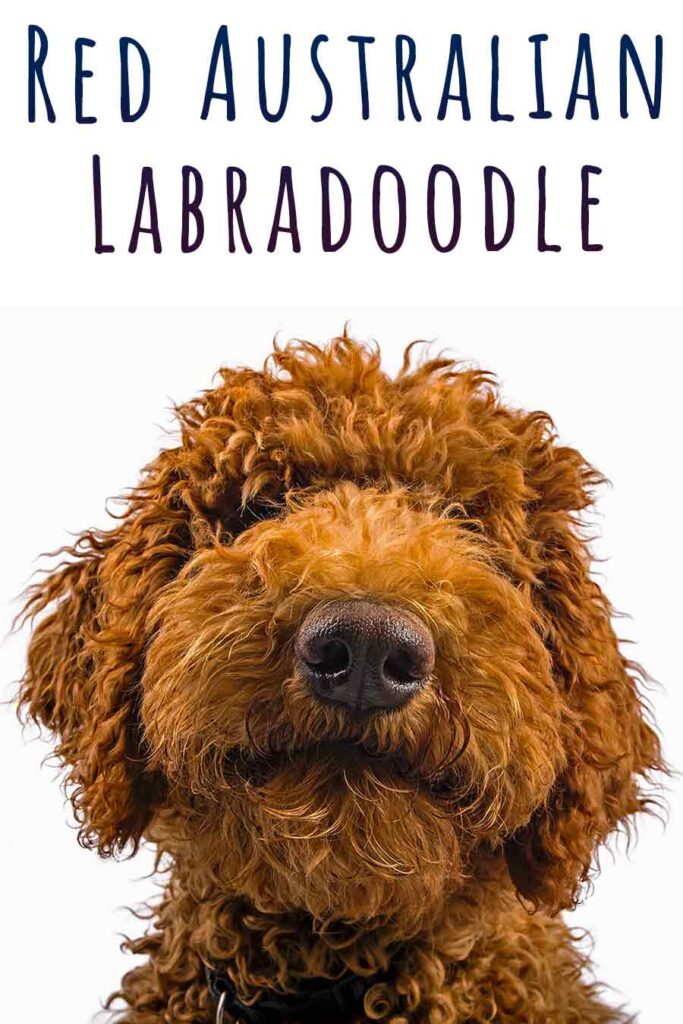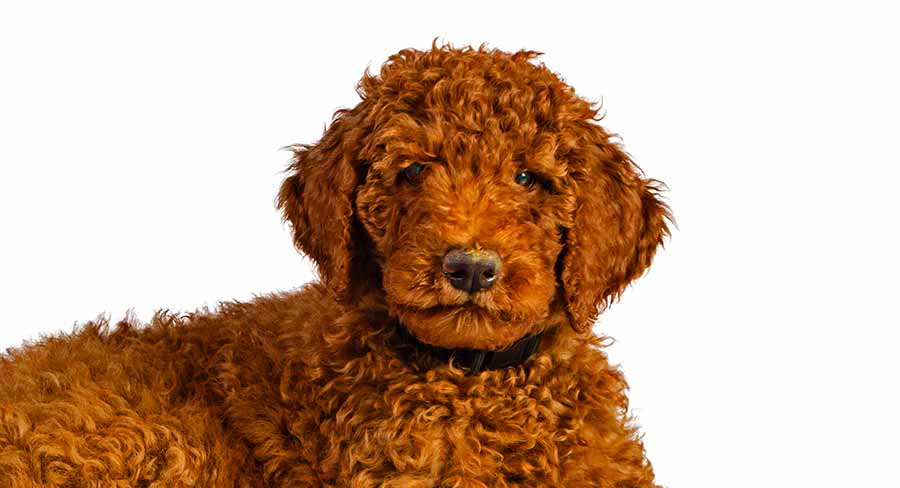Are you ready to meet the red Australian Labradoodle? This article has everything you need to know about red Labradoodle coats, from apricot to russet.
Red Australian Labradoodle puppies are part of a worldwide breeding project to get some multigenerational Labradoodle lines recognized as a new pedigree in their own right. The Australian Labradoodle breed standard recognizes 6 solid coat colors, including red. The exact shade of red coloring can vary from individual to individual, but their charming personality should always remain the same!
In This Article
- What is a red Australian Labradoodle?
- Red Australian Labradoodle genetics
- Red Labradoodle Temperament
- Health and care
- The mini red Australian Labradoodle
- Finding red Australian Labradoodle puppies
What is a Red Australian Labradoodle?
Australian Labradoodles differ from other Labradoodles because they are no longer first generation offspring of Labradors and Poodles. First generation Doodles have been gaining popularity since the 1980s, when they were originally trialled as hypoallergenic service dogs. (Spoiler: they’re not reliably hypoallergenic.) In the 1990s, fans of the Labradoodle decided to try and capture all their best qualities in a new pedigree dog breed, called the Australian Labradoodle. The breeding project started in Australia, but now Australian Labradoodles are popular all over the world.
The international governing body for Australian Labradoodle breeders is the Worldwide Australian Labradoodle Association (WALA). Their breed standard approves 6 possible solid coat colors:
- Black
- Cream
- Chocolate
- Lavender
- Caramel
- Red
In addition, several patterns are allowed, including:
- White trim. White paws, bib, and tail tip set against another color.
- Particolor. Large areas of white on another color.
- Phantom. A second color on the eyebrows, muzzle, chest and paws.
- Sable. Each individual hair has bands of light and dark pigment.
- Brindle. Narrow irregular stripes of color.
Finally, some red Aussie Labradoodles carry the merle gene and have red merle coats. However, these dogs don’t qualify for full breed registration, and WALA strongly discourages breeding from them.
Shades of red
One of the most exciting things about red Australian Labradoodles and red and white Australian Labradoodles is that ‘red’ covers so many different shades of pigment. Red Labradoodles can be anything from bright gold to a deep rusty hue, via several shades of warm apricots and marmalades. What they all have in common, and which means they’re recorded as red on their pedigree certificate, is that their eyes are dark brown, and their nose and gums are black.

Even more intriguingly, red Labradoodles aren’t the only type of Doodle that can be red! A caramel Labradoodle can be many shades, from a warm cream color, through to a bright fiery red. So what makes a red caramel Australian Labradoodle ‘caramel’ and not ‘red’ on their pedigree certificate? Again, the answer is in their eyes and on their nose. Caramel Labradoodles have light hazel eyes, and a brown nose.
So red Labradoodles don’t have to be red, caramel Labradoodles can be red, and two Labradoodles with very similar colored coats can actually be different colors on their pedigree certificate, depending on the color of their eyes and nose. If that all sounds strange, then the next section will make it all make sense!
Red Australian Labradoodle Genetics
Both red and caramel Labradoodles have two copies of a special gene called Recessive Yellow. It’s called recessive because it only affects coat color when a puppy inherits two copies of it – one from each of their parents. If they only inherit one copy, that copy sits silently into the background and doesn’t affect coat color at all. And it’s called ‘yellow’ because (unsurprisingly) it contains the genetic instructions for making yellow pigment.
But here’s where the magic happens. All Labradoodles also carry a set of genetic instructions to make either black or brown pigment. But not both. So:
- Labradoodle puppies who make yellow pigment and black pigment are red.
- And Labradoodle puppies who make yellow pigment and brown pigment are caramel.
In either case, the exact shade of their fur varies depending on a range of other genes as well. But the color of their nose always reveals whether their coat is black-based or brown-based, and therefore whether they should properly be described as red, or caramel.
Red and white Australian Labradoodle dogs
Red Australian Labradoodle puppies with white patches of fur also carry White Spotting genes. There is thought to be a series of White Spotting genes. Alternative options in the series are responsible for white trim markings, particolor white markings, and extreme white markings.
Red Australian Labradoodle Temperament
So there are some pretty clever genes controlling Labradoodle coat color, but do any of them affect their personality too? The answer to this is apparently not. There is no genetic evidence or even anecdotal evidence that Australian Labradoodle color affects their temperament.
This might be at odds with stories you’ve heard about purebred Labradors. In the Labrador Retriever breed, black coats are closely associated with highly skilled working dogs, and yellow coats are closely associated with calm service dogs. This is due to breeders pursuing both of these traits simultaneously, not because they are somehow connected at a genetic level. But, it has always been a trend rather than a rule, and most Australian Doodles are now so many generations removed from their closest pedigree Labrador relative, this trend has been lost.
Aussie Doodles are active, friendly, smart and affectionate. They enjoy human company, playtime, and training games. Color doesn’t affect their temperament, but some factors which do play a part in their personality are:
- Their parents’ temperaments.
- Whether they’re male or female.
- Early socialisation.
- And meeting their need for physical activity and mental stimulation.
Since they were founded in the 1990s, selective breeding has resulted in a Australian Labradoodle population which is genetically much closer to Poodles than Labradoodles. And you might feel like you can see that in either their looks, temperament, or health.
Red Australian Labradoodle Health & Care
Dogs belonging to this new breed are prone to:
- Hip dysplasia
- Elbow dysplasia
- Eye diseases
- Thyroid disease
- Ear infections
- Obesity
There’s no evidence that their coat color changes a red Labradoodle’s risk of any of these conditions. Choosing puppies from health tested parents and keeping them at a healthy weight are important ways of protecting them against orthopedic diseases including hip and elbow dysplasia. Keeping your Doodle at a healthy weight also helps to protect them from diabetes and heart disease.
Doodles are prone to ear infections because their heavy, furry ears trap warmth and moisture, which makes an ideal breeding ground for bacterial and fungal infections. Especially if they love to swim and dirty water gets trapped in their ears! Gently washing and drying their ears regularly will help keep them healthy.
What About A Mini Red Australian Labradoodle?
Did you know that a full grown Australian Labradoodle can weigh 65lbs? They give big fleecy hugs, but their size means they’re not suitable for everyone. However, the WALA also register mini Australian Labradoodle dogs. Miniature Australian Labradoodle breeding lines have toy or miniature Poodles in them, to produce Doodles in a smaller size. A full grown miniature Labradoodle weighs around 15 to 20lbs. They can be any of the same beautiful colors a standard Australian Labradoodle can, including red and red caramel.
There’s a medium red Australian Labradoodle too!
Not too big and not to small, a medium red Australian Labradoodle is the goldilocks of sizes. The WALA places dogs in their medium category if they stand between 17 and 20 inches tall at the shoulders – about the same size as a Springer Spaniel. Once you’ve settled on your ideal size, next let’s look at how to find red Labradoodle breeders.
Finding Red Australian Labradoodle Puppies
Aussie Labradoodle popularity has been increasing year on year as more and more people find out about them. Reds, caramels and apricots are also amongst the most popular colors for these dogs, so finding red Labradoodle breeders is fairly straightforward. The WALA keeps a directory of accredited breeders, as do smaller regional Australian Labradoodle clubs. Also, red and red caramel Labradoodle coats are inherited in a predictable way via known genes. So breeders can usually predict whether a planned mating is likely to produce red puppies. However, owing to their popularity, you might have to join a waiting list for a suitable unreserved litter.
Whilst having a color preference for your puppy is natural, it’s vitally important not to forfeit their health to get the color you want. Good quality puppies come from red Labradoodle breeders who health test their breeding dogs for
- Hip Dysplasia
- Elbow Dysplasia
- Eye Examination
- EIC (Exercise Induced Collapse)
- Progressive Retinal Atrophy (PRA) DNA Test
Your Red Aussie Doodle
Red dogs are beautiful and sometimes surprising. Some of them aren’t officially red at all! Whilst some Doodles that are technically red actually look golden or apricot colored. These eye-catching dogs have the potential to be great pets for the right households, but they need lots of exercise and interaction. Like all Doodles, they’re vulnerable to some distressing and expensive medical conditions. So it’s vital to choose a puppy from health tested parents, and take good care of them.
Do you already have a red or red and white Australian Labradoodle? Tell us about them in the comments box down below!
Don’t Miss
Don’t miss your chance to find out about these other Doodle types before you go:
- Giant Labradoodle
- Apricot Labradoodle
- Cream Labradoodle
- Black and White Labradoodle
- Brown Labradoodle
- Orange Labradoodle
- Cobberdog vs Labradoodle
References and Resources
Ali. Genetic analysis of the modern Australian labradoodle dog breed reveals an excess of the poodle genome. PLOS Genetics. 2020.
Kaelin & Barsh. Genetics of Pigmentation in Dogs and Cats. Annual Review of Animal Biosciences. 2013.

